Marketing around holidays is a great way to connect with your audience and drive engagement. Holidays bring people together, creating opportunities for businesses to reach consumers when they’re actively celebrating or shopping.
A global approach to holiday campaigns can open doors to new markets and help businesses resonate with diverse audiences. By planning around key dates, marketers can align their strategies with moments that matter most to their customers.
This guide provides an overview of the key international holidays in 2025 to help marketers create campaigns that are timely, relevant, and impactful.
Why Marketers Should Plan Around Holidays
Holidays influence consumer behavior, often leading to higher spending. Whether it’s shopping for gifts, preparing festive meals, or booking travel, holidays present businesses with opportunities to meet consumer needs.
Planning around holidays also helps brands maintain visibility and relevance. By participating in culturally significant moments, marketers can engage customers on an emotional level.
For businesses with a global reach, understanding international holidays is essential. Campaigns that resonate with local customs and traditions foster stronger connections, making your brand more relatable to different audiences.
Upcoming International Holidays in 2025
January
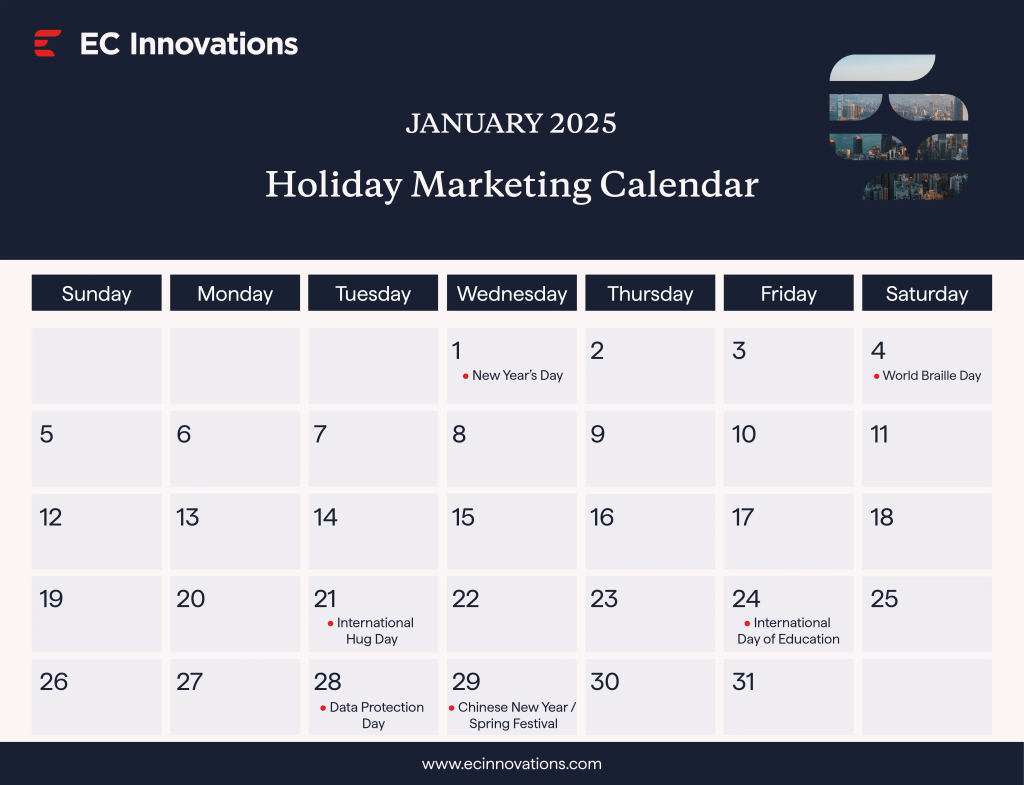
January is a time for new beginnings and global celebrations. New Year’s Day on January 1 sets the tone for resolutions and fresh starts. This year, the Chinese New Year falls on January 29, marking a significant occasion for East Asian communities. It’s an ideal time to engage with audiences through cultural appreciation and festive campaigns.
- January 1 – New Year’s Day
- January 4 – World Braille Day
- January 21 – International Hug Day
- January 24 – International Day of Education
- January 28 – Data Protection Day
- January 29 – Chinese New Year / Spring Festival
February
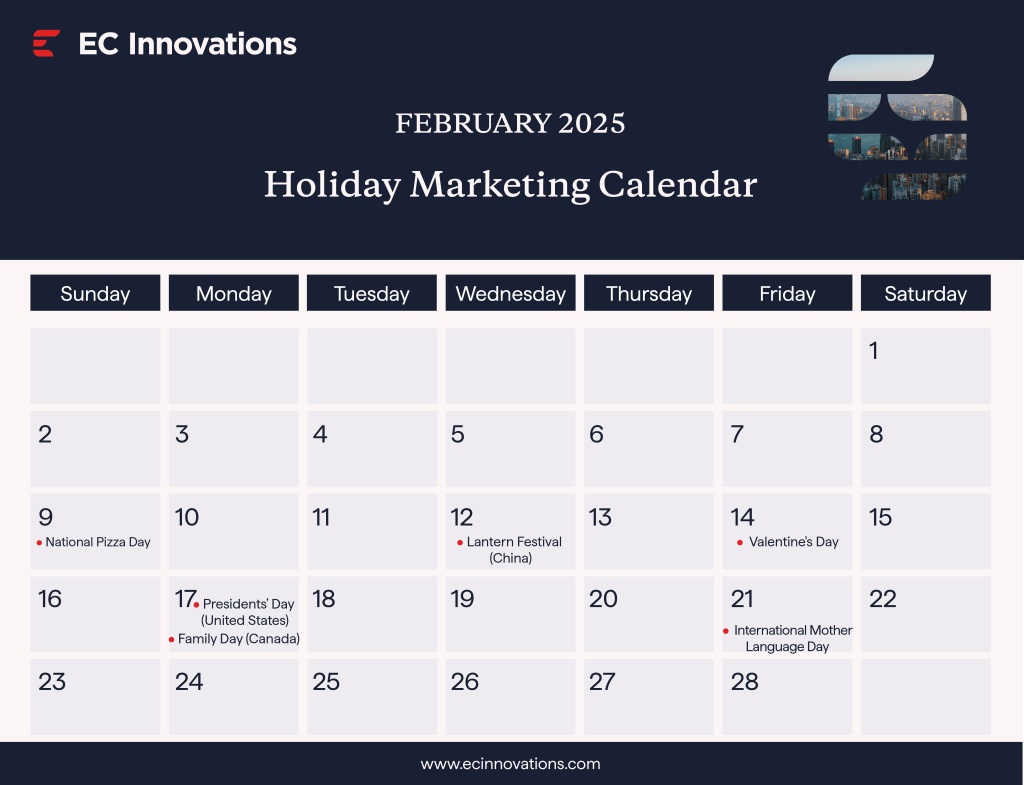
February is synonymous with love and celebration. Valentine’s Day on February 14 continues to dominate the month. In 2024, US consumers spent a total of $25.8 billion on celebrating Valentine’s Day, according to the annual survey released by the National Retail Federation and Prosper Insights & Analytics. It’s also a time to celebrate diversity with Black History Month in the U.S. and LGBT History Month in the UK. This month offers opportunities to recognize and amplify stories of love, equality, and community.
- Month of February – Black History Month/ LGBT History Month
- February 9 – National Pizza Day
- February 12 – Lantern Festival (China)
- February 14 – Valentine’s Day
- February 17 – Presidents’ Day (United States), Family Day (Canada)
- February 21 – International Mother Language Day
March
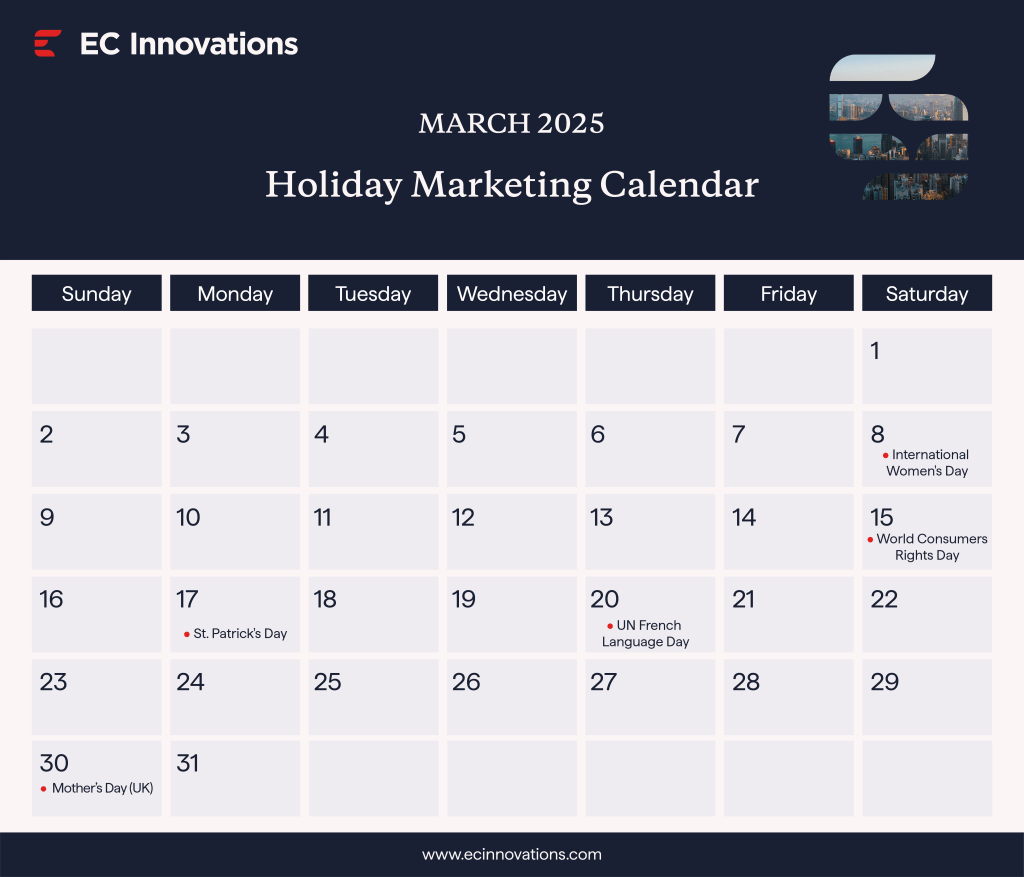
March is all about empowerment, cultural traditions, and seasonal changes. International Women’s Day focuses on gender equality, while St. Patrick’s Day and Mother’s Day in the UK highlight celebrations tied to heritage and family.
- Month of March – Women’s History Month
- March 8 – International Women’s Day
- March 15 – World Consumers Rights Day
- March 17 – St. Patrick’s Day
- March 20 – UN French Language Day
- March 30 – Mother’s Day in the UK.
April
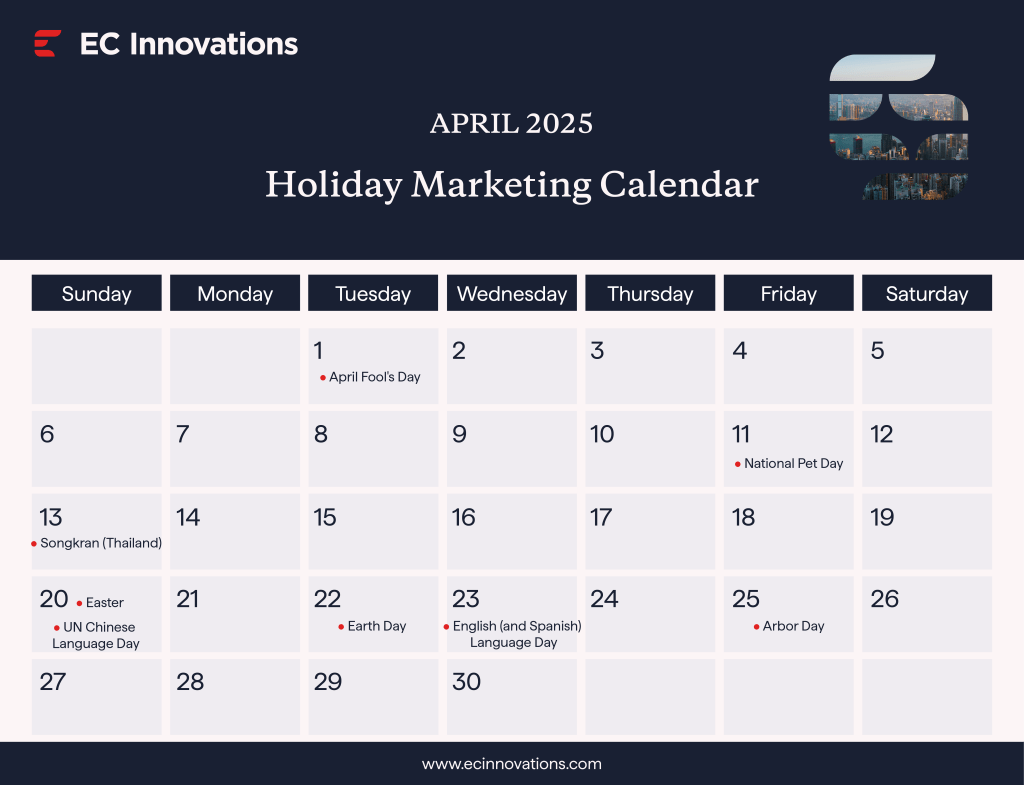
April is a month of renewal and environmental awareness. Earth Day on April 22 encourages sustainable initiatives, while Easter often brings a mix of faith-based and secular celebrations. Don’t forget regional events like Songkran in Thailand, which mark the start of new beginnings.
- April 1 – April Fool’s Day
- April 11 – National Pet Day
- April 13 – Thai New Year (Songkran) in Thailand
- April 20 – Easter, UN Chinese Language Day
- April 22 – Earth Day
- April 23 – UN English Language Day, UN Spanish Language Day
- April 25 – Arbor Day
May
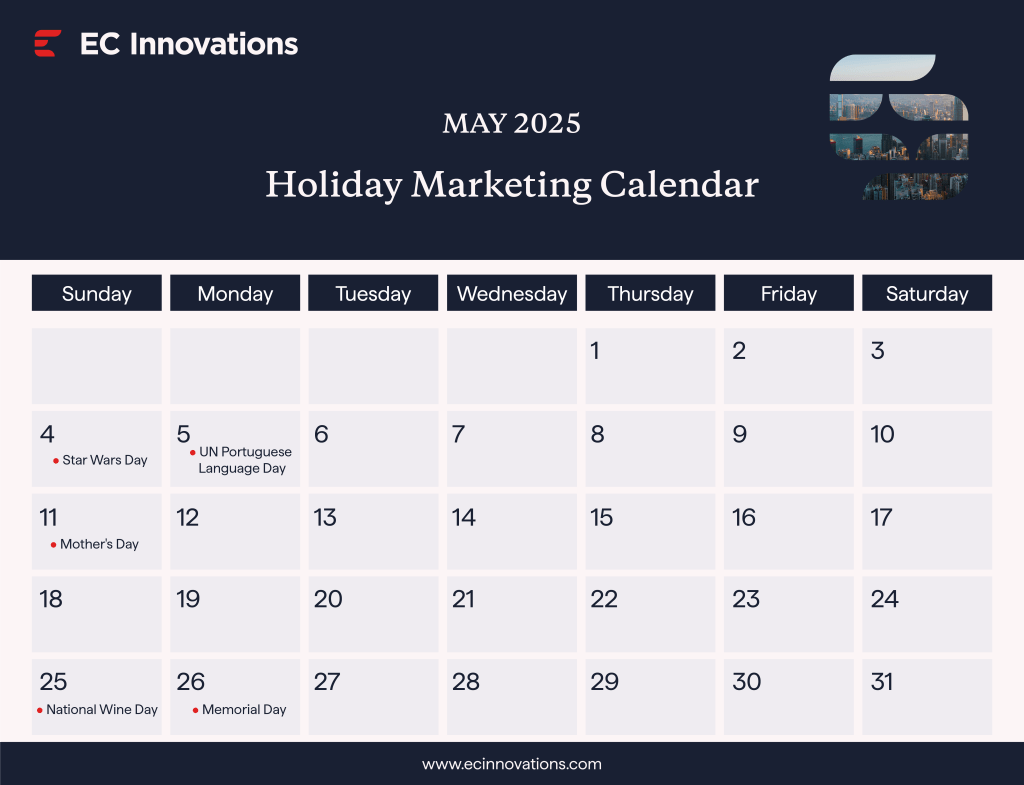
May celebrates cultural heritage, family, and life’s lighter moments. From Mother’s Day to Memorial Day, this month offers opportunities to honor loved ones and reflect on meaningful traditions.
- May 4 – Star Wars Day
- May 5 – UN Portuguese Language Day
- May 11 – Mother’s Day
- May 25 – National Wine Day
- May 26 – Memorial Day
June
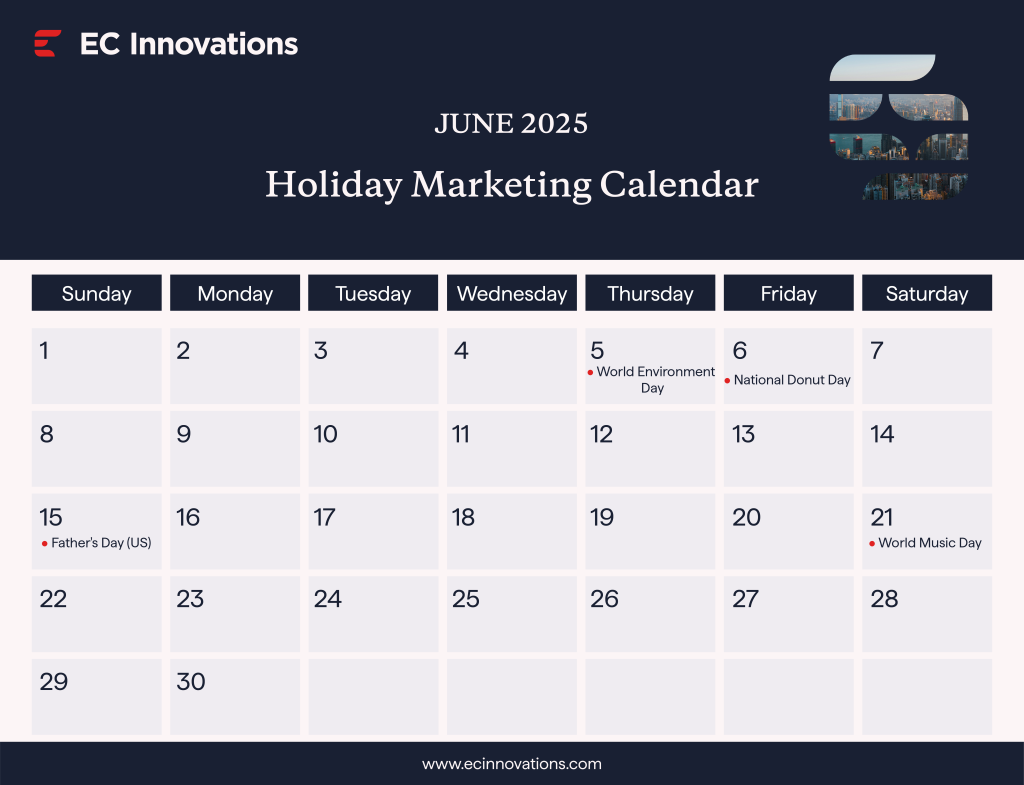
June is all about pride and summer celebrations. Pride Month highlights LGBTQ+ communities, and Father’s Day offers opportunities to connect with family-oriented audiences. The beginning of summer also opens doors for seasonal promotions.
- Month of June – Pride Month
- June 5 – World Environment Day
- June 6 – National Donut Day
- June 15 – Father’s Day (US)
- June 21 – World Music Day
July
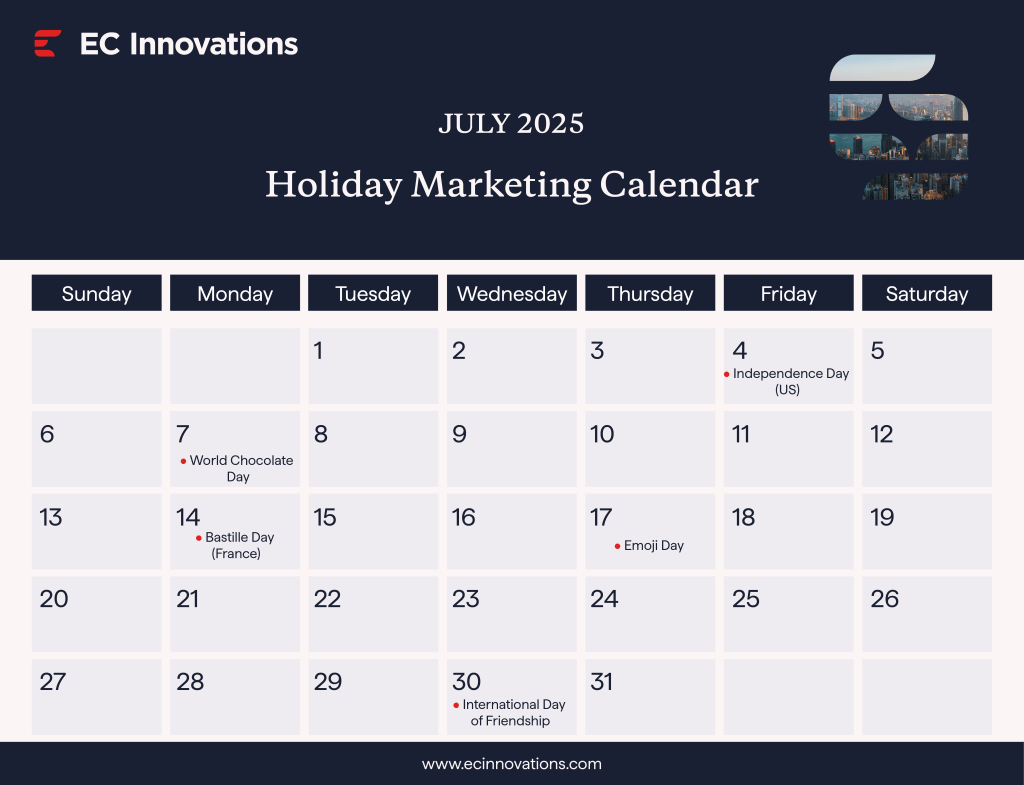
July brings summer’s peak in many parts of the world. Independence Day in the U.S. (July 4) offers patriotic themes, while Bastille Day in France highlights French culture. It’s also an excellent time for travel-related campaigns as families plan vacations. Lighthearted celebrations like World Emoji Day add to the fun and creativity for marketers.
- July 4 – Independence Day (US)
- July 7 – World Chocolate Day
- July 14 – Bastille Day (France)
- July 17 – Emoji Day
- July 30 – International Day of Friendship
August
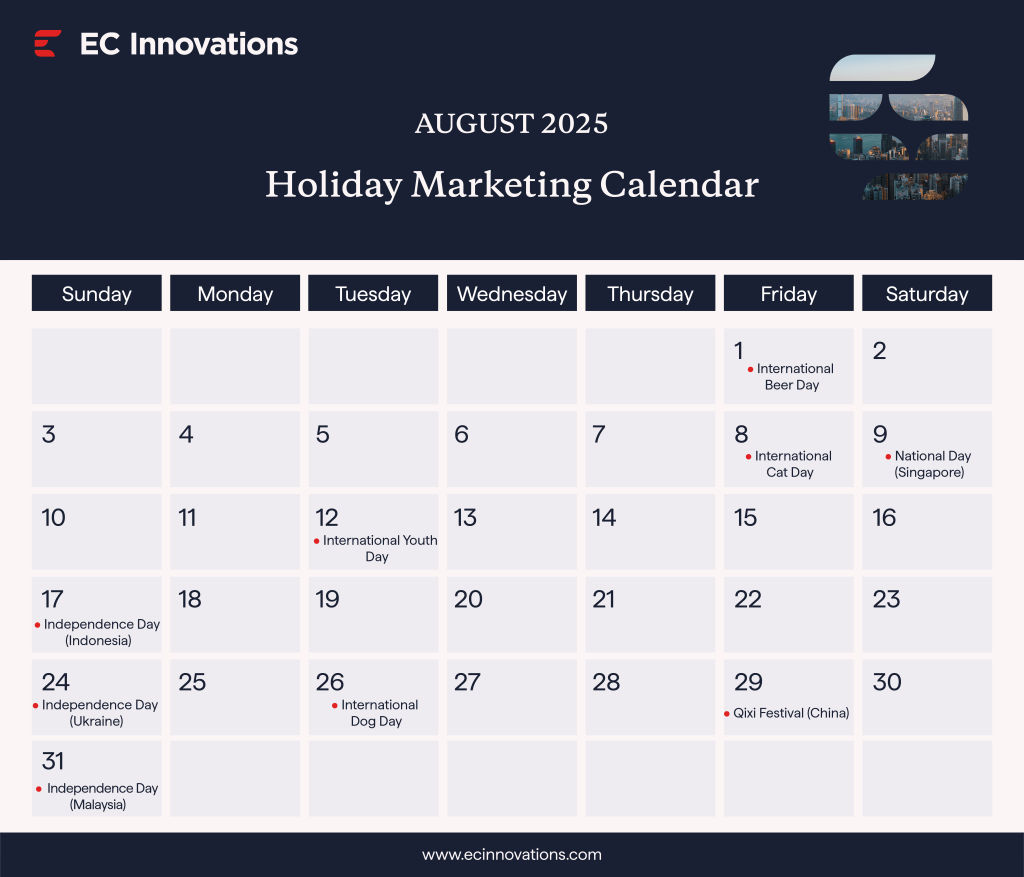
August balances the excitement of summer with the preparation for back-to-school season. Families are busy shopping for essentials, making it a great time for marketers to offer promotions tailored to students and parents. National and cultural celebrations like International Youth Day (August 12) and Qixi Festival (August 29) provide opportunities for creative, inclusive campaigns.
- Month of August – Back to School
- August 1 – International Beer Day
- August 8 – International Cat Day
- August 9 – National Day (Singapore)
- August 12 – International Youth Day
- August 17 – Independence Day (Indonesia)
- August 24 – Independence Day (Ukraine)
- August 26 – International Dog Day
- August 29 – Qixi Festival (China)
- August 31 – Independence Day (Malaysia)
September
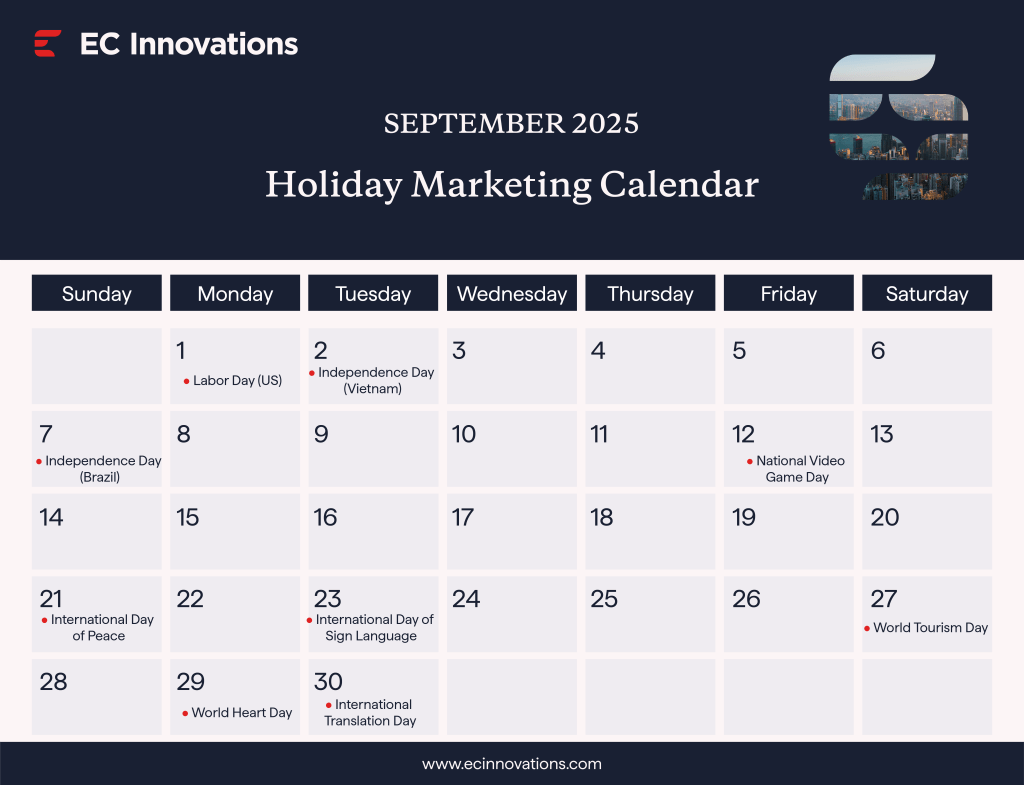
September signals change, with back-to-school promotions and the start of autumn in the Northern Hemisphere. Labor Day in the U.S. provides opportunities to honor workers.
- September 1 – Labor Day (US)
- September 2 – Independence Day (Vietnam)
- September 7 – Independence Day (Brazil), Father’s Day (Australia)
- September 12 – National Video Game Day
- September 21 – International Day of Peace
- September 23 – International Day of Sign Language
- September 27 – World Tourism Day
- September 29 – World Heart Day
- September 30 – International Translation Day
October
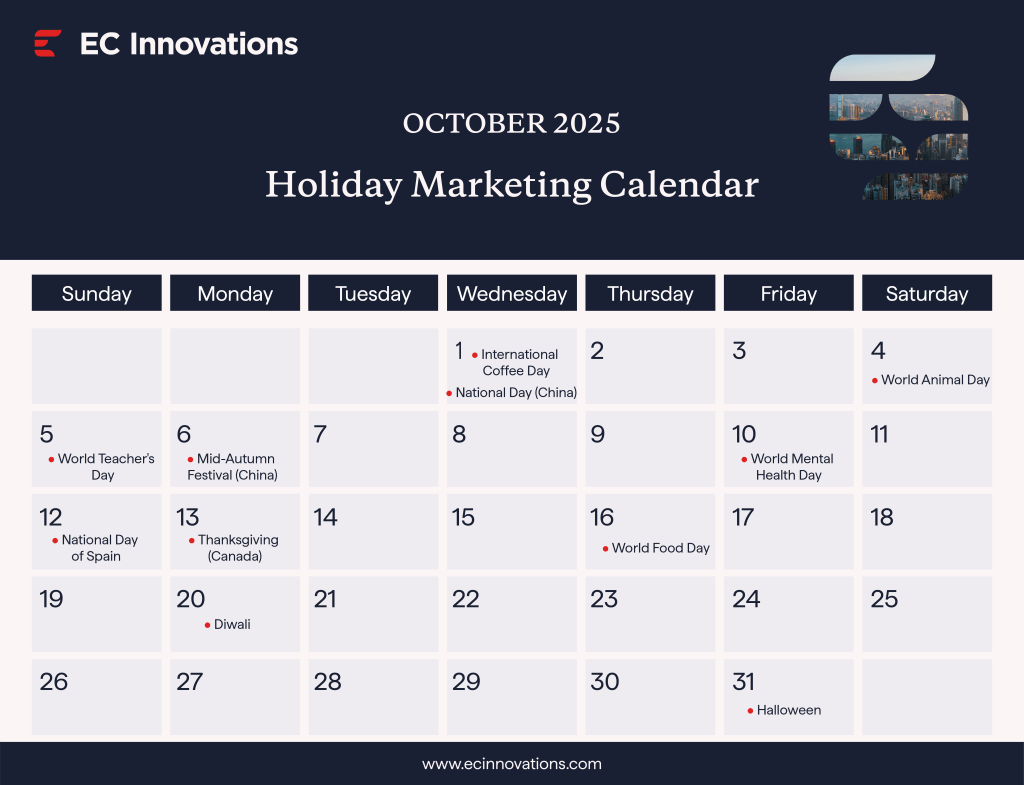
October blends seasonal charm with cultural significance. Halloween dominates the latter half of the month, offering endless creative opportunities. Mid-Autumn Festival and Diwali are other important cultural touchpoints.
- October 1 – National Day (China), International Coffee Day
- October 4 – World Animal Day
- October 5 – World Teacher’s Day
- October 6 – Mid-Autumn Festival (China)
- October 10 – World Mental Health Day
- October 12 – National Day of Spain
- October 13 – Thanksgiving (Canada)
- October 16 – World Food Day
- October 20 – Diwali
- October 31 – Halloween
November
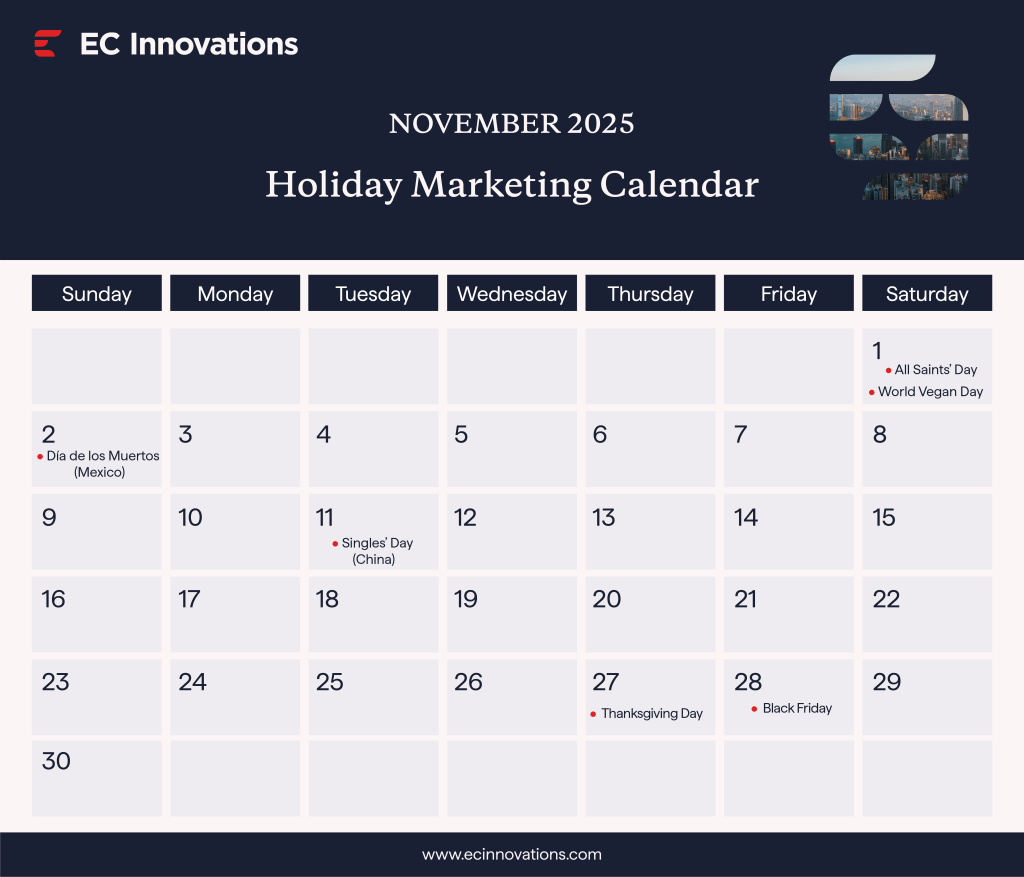
November centers on gratitude, giving, and shopping. Thanksgiving marks a time for reflection and family gatherings in the U.S., while Black Friday and Cyber Monday drive significant retail activity. Globally, Singles’ Day (November 11) in China has gained prominence as a record-breaking e-commerce event, offering brands a chance to connect with online shoppers worldwide.
- November 1: All Saints’ Day
- November 1 – World Vegan Day
- November 1-2 – Día de los Muertos/Day of the Dead (Mexico)
- November 11 – Singles’ Day (China)
- November 27 – Thanksgiving Day (fourth Thursday)
- November 28 – Black Friday
December
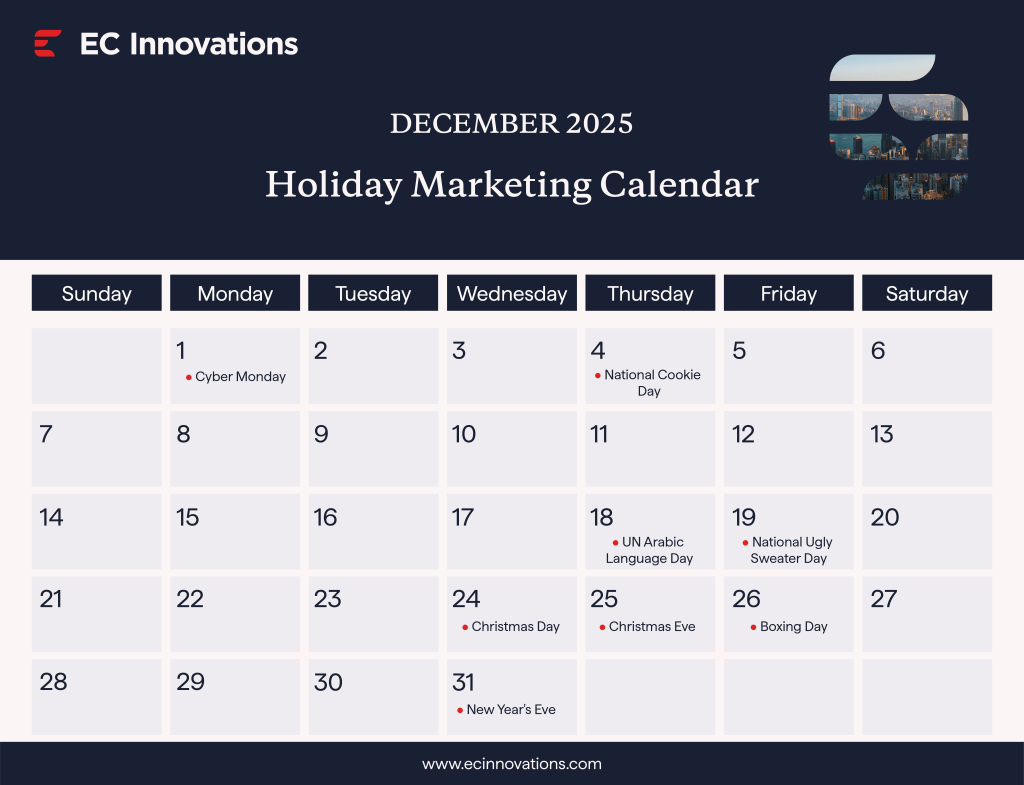
December marks the height of holiday marketing, with Christmas as the centerpiece of celebrations. It’s a season for reflecting on the year, spreading goodwill, and creating emotional connections with audiences. The New Year’s Eve countdown provides a final opportunity for brands to engage with customers and close the year on a memorable note.
- December 1 – Cyber Monday
- December 4 – National Cookie Day
- December 18 – UN Arabic Language Day
- December 19 – National Ugly Sweater Day
- December 24 – Christmas Eve (Christian holiday).
- December 25 – Christmas Day (Christian holiday).
- December 26 – Boxing Day
- December 31 – New Year’s Eve
Tips for Creating Successful Holiday Campaigns
1. Plan Ahead
Successful holiday campaigns start with early preparation. Create a calendar marking key dates relevant to your target audience and set clear goals for each campaign. Begin brainstorming ideas, designing content, and setting up logistics months in advance to avoid last-minute stress. Use historical data to analyze past performance, customer behavior, and trends to make informed decisions. For example, if specific promotions worked well last year, consider how they can be improved or expanded.
2. Understand Your Audience
Not every holiday resonates equally with every audience. Research the traditions, cultural significance, and expectations surrounding each holiday your target market celebrates. For instance, while Valentine’s Day may call for romantic themes in Western countries, it might focus more on friendship or family in other regions. Segment your audience and tailor your messaging to their values, ensuring your campaigns feel personal and relevant.
3. Be Creative and Authentic
Stand out by being innovative and genuine in your campaigns. Use vibrant visuals, memorable slogans, and stories that connect emotionally with your audience. Incorporate user-generated content, like holiday-themed posts or reviews, to create authenticity. Avoid overused phrases or generic ideas, as they can make your campaign blend into the noise. For example, a campaign that ties your product to a heartfelt story or a unique cultural tradition can leave a lasting impression.
4. Offer Value
Make your audience feel special by offering real value during holiday campaigns. Discounts, exclusive bundles, and free shipping are common incentives that drive engagement and conversions. You can also add value by creating helpful resources, such as gift guides or tips for holiday planning. Show how your product or service can enhance holiday experiences, whether it’s simplifying celebrations, solving a problem, or making the season more memorable.
5. Use Multiple Channels
Maximize your reach by promoting your campaigns across multiple platforms. Email marketing is effective for personalized offers and reminders, while social media amplifies visibility through creative posts, reels, and ads. Update your website with holiday-themed landing pages, banners, or pop-ups. Adjust your content to suit the strengths of each channel—short, engaging videos for platforms like Instagram and TikTok, and detailed blogs or guides for your website.
6. Localize for Local Market
For global audiences, localization is crucial to making holiday campaigns impactful. This involves adapting messaging and visuals, and offering products that align with local customs and cultural preferences. For example, a campaign for Chinese New Year might include traditional colors like red and gold and emphasize themes of prosperity and family. Localization ensures your campaigns feel authentic and relatable, building trust and engagement with global audiences.
Also read: A Comprehensive Guide to Marketing Translation
7. Measure, analyze, and adjust
Once your campaign is live, track its performance using key metrics like engagement rates, conversions, and customer feedback. Analyzing this data helps identify what worked and what didn’t, allowing you to optimize future campaigns. Be flexible and ready to make real-time adjustments if needed, such as tweaking ads, refining offers, or improving messaging based on audience response.
Final Thoughts
Holidays present a unique opportunity to engage audiences, increase visibility, and drive results. With careful planning, creativity, and cultural awareness, you can create campaigns that resonate and drive results.
Looking for expert help with creating campaigns that reach global audiences? Our team can help you craft multilingual, culturally relevant campaigns that drive results. Contact us today to start planning your holiday marketing strategy!



